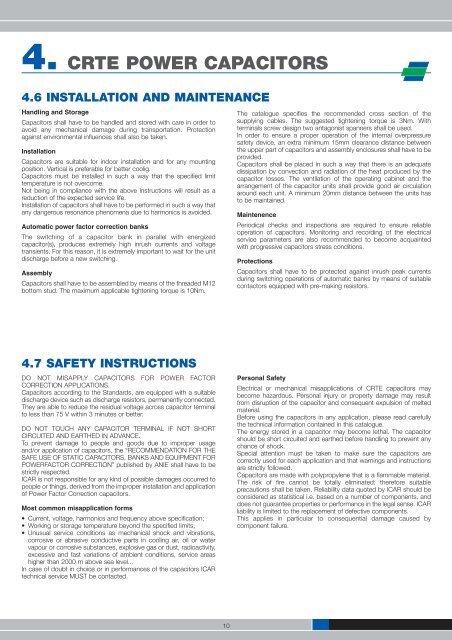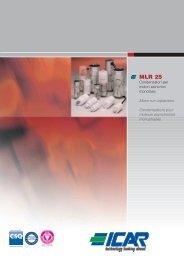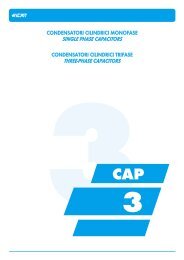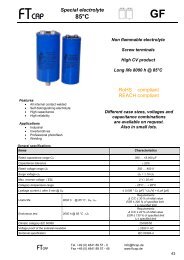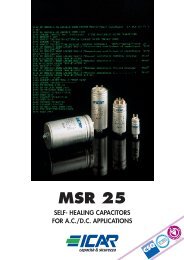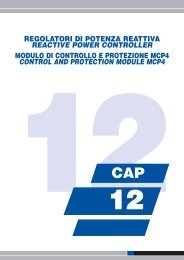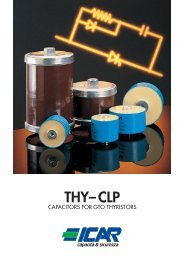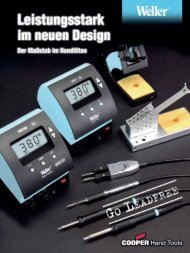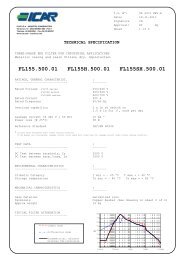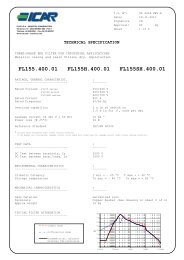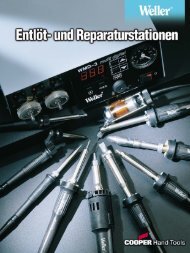4. crte power capacitors - IVD GmbH
4. crte power capacitors - IVD GmbH
4. crte power capacitors - IVD GmbH
Create successful ePaper yourself
Turn your PDF publications into a flip-book with our unique Google optimized e-Paper software.
<strong>4.</strong> CRTE POWER CAPACITORS<br />
<strong>4.</strong>6 INSTALLATION AND MAINTENANCE<br />
Handling and Storage<br />
Capacitors shall have to be handled and stored with care in order to<br />
avoid any mechanical damage during transportation. Protection<br />
against environmental influences shall also be taken.<br />
Installation<br />
Capacitors are suitable for indoor installation and for any mounting<br />
position. Vertical is preferable for better coolig.<br />
Capacitors must be installed in such a way that the specified limit<br />
temperature is not overcome.<br />
Not being in compliance with the above instructions will result as a<br />
reduction of the expected service life.<br />
Installation of <strong>capacitors</strong> shall have to be performed in such a way that<br />
any dangerous resonance phenomena due to harmonics is avoided.<br />
Automatic <strong>power</strong> factor correction banks<br />
The switching of a capacitor bank in parallel with energized<br />
capacitor(s), produces extremely high inrush currents and voltage<br />
transients. For this reason, it is extremely important to wait for the unit<br />
discharge before a new switching.<br />
Assembly<br />
Capacitors shall have to be assembled by means of the threaded M12<br />
bottom stud. The maximum applicable tightening torque is 10Nm.<br />
<strong>4.</strong>7 SAFETY INSTRUCTIONS<br />
DO NOT MISAPPLY CAPACITORS FOR POWER FACTOR<br />
CORRECTION APPLICATIONS.<br />
Capacitors according to the Standards, are equipped with a suitable<br />
discharge device such as discharge resistors, permanently connected.<br />
They are able to reduce the residual voltage across capacitor terminal<br />
to less than 75 V within 3 minutes or better.<br />
DO NOT TOUCH ANY CAPACITOR TERMINAL IF NOT SHORT<br />
CIRCUITED AND EARTHED IN ADVANCE.<br />
To prevent damage to people and goods due to improper usage<br />
and/or application of <strong>capacitors</strong>, the “RECOMMENDATION FOR THE<br />
SAFE USE OF STATIC CAPACITORS, BANKS AND EQUIPMENT FOR<br />
POWERFACTOR CORRECTION” published by ANIE shall have to be<br />
strictly respected.<br />
ICAR is not responsible for any kind of possible damages occurred to<br />
people or things, derived from the improper installation and application<br />
of Power Factor Correction <strong>capacitors</strong>.<br />
Most common misapplication forms<br />
• Current, voltage, harmonics and frequency above specification;<br />
• Working or storage temperature beyond the specified limits;<br />
• Unusual service conditions as mechanical shock and vibrations,<br />
corrosive or abrasive conductive parts in cooling air, oil or water<br />
vapour or corrosive substances, explosive gas or dust, radioactivity,<br />
excessive and fast variations of ambient conditions, service areas<br />
higher than 2000 m above sea level...<br />
In case of doubt in choice or in performances of the <strong>capacitors</strong> ICAR<br />
technical service MUST be contacted.<br />
10<br />
The catalogue specifies the recommended cross section of the<br />
supplying cables. The suggested tightening torque is 3Nm. With<br />
terminals screw design two antagonist spanners shall be used.<br />
In order to ensure a proper operation of the internal overpressure<br />
safety device, an extra minimum 15mm clearance distance between<br />
the upper part of <strong>capacitors</strong> and assembly enclosures shall have to be<br />
provided.<br />
Capacitors shall be placed in such a way that there is an adequate<br />
dissipation by convection and radiation of the heat produced by the<br />
capacitor losses. The ventilation of the operating cabinet and the<br />
arrangement of the capacitor units shall provide good air circulation<br />
around each unit. A minimum 20mm distance between the units has<br />
to be maintained.<br />
Maintenence<br />
Periodical checks and inspections are required to ensure reliable<br />
operation of <strong>capacitors</strong>. Monitoring and recording of the electrical<br />
service parameters are also recommended to become acquainted<br />
with progressive <strong>capacitors</strong> stress conditions.<br />
Protections<br />
Capacitors shall have to be protected against inrush peak currents<br />
during switching operations of automatic banks by means of suitable<br />
contactors equipped with pre-making resistors.<br />
Personal Safety<br />
Electrical or mechanical misapplications of CRTE <strong>capacitors</strong> may<br />
become hazardous. Personal injury or property damage may result<br />
from disruption of the capacitor and consequent expulsion of melted<br />
material.<br />
Before using the <strong>capacitors</strong> in any application, please read carefully<br />
the technical information contained in this catalogue.<br />
The energy stored in a capacitor may become lethal. The capacitor<br />
should be short circuited and earthed before handling to prevent any<br />
chance of shock.<br />
Special attention must be taken to make sure the <strong>capacitors</strong> are<br />
correctly used for each application and that warnings and instructions<br />
are strictly followed.<br />
Capacitors are made with polypropylene that is a flammable material.<br />
The risk of fire cannot be totally eliminated; therefore suitable<br />
precautions shall be taken. Reliability data quoted by ICAR should be<br />
considered as statistical i.e. based on a number of components, and<br />
does not guarantee properties or performance in the legal sense. ICAR<br />
liability is limited to the replacement of defective components.<br />
This applies in particular to consequential damage caused by<br />
component failure.


